Japan Wood Products
Prices
Dollar Exchange Rates of
10th December 2014
Japan Yen 117.89
Reports From Japan
Consumer confidence continues to falter
Cabinet Office data on consumer confidence for
November showed an unexpectedly steep decline. As a
result of this the government had to come to terms with the
reality that consumer confidence remains weak.
The overall consumer confidence index for general
households, which includes consumer perceptions on
income and job prospects, was at 37.7 in November down
1.2 points from the previous month and the lowest since
April this year.
The index is split between several categories of consumer
perceptions. The November data reports that the livelihood
index stood at 34.9 (down 1.5 from the previous month);
the income growth index, at 37.6, was down 0.4 from the
previous month; the employment index was 42.8 (down
1.9 from the previous month) and the willingness to buy
durable goods index stood at 35.4, down 1.1 from the
previous month.
For more see:
http://www.esri.cao.go.jp/en/stat/shouhi/shouhi-e.html#cci

After 4 positive months BSI reverses course
The latest report from Japan‟s Economic and Social
Research Institute shows a decline in the business
sentiment index (BSI), even among large Japanese
companies.
The index is compiled to reflect the difference between
enterprises assessing business conditions as improving
from the previous quarter and that of companies
experiencing a decline in business conditions.
See:
http://www.esri.cao.go.jp/en/stat/hojin/h26hojin/141012yo
soku-e.html

It came as no surprise that the sentiment index for small
enterprises in Japan was in negative territory as it has been
for the past three quarters of the year. Japan's economy fell
into recession in the third quarter and consumer
confidence has been trending down for months.
Machinery orders down after 4 straight monthly
increases
One of the leading indicators of private sector investment,
core machinery orders, fell 6.4% month on month and
4.9% year on year, bringing to an end the rises reported
over the past 4 months.
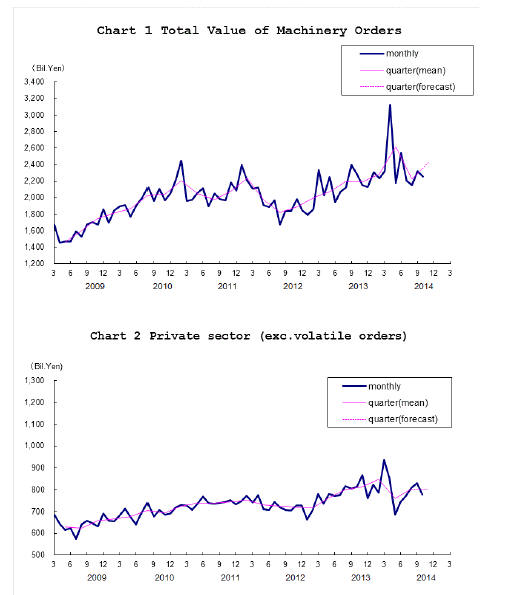
The Cabinet Office report says: “The total value of
machinery orders received by 280 manufacturers operating
in Japan declined by 2.9% in October from the previous
month on a seasonally adjusted basis.
Private-sector machinery orders, excluding volatile ones
for ships and those from electric power companies,
declined a seasonally adjusted by 6.4% in October.
These disappointing numbers must be viewed against the
recent four consecutive monthly increases and the Cabinet
Office is maintaining its stance that the economy is on a
recovery track.
For more see:
http://www.esri.cao.go.jp/en/stat/juchu/juchu-e.html
Trends in wooden window frame imports
Japan‟s imports of wooden window frames from 2009 to
2013 are shown below. Between 2009 and 2012 there was
a steady decline in imports of wooden window frames but
imports picked up again in 2013.

From 2009 to 2012 imports of wooden window frames fell
around 19% from yen 5,191 mil. to yen 4,200 mil. but in
2013 imports rose 27% to yen 5,315 mil. reflecting the
improved housing market trend.
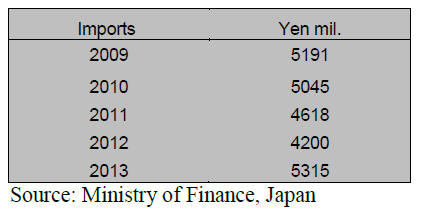
First half 2014 imports of wooden window frames
averaged around yen 4,600 mil. but figures from Japan‟s
Ministry of Finance show third quarter imports collapsed
by almost 45%, the worst quarter imports for a decade.
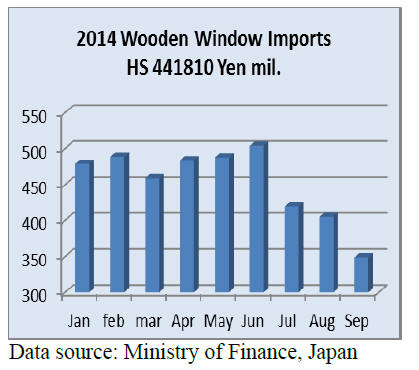 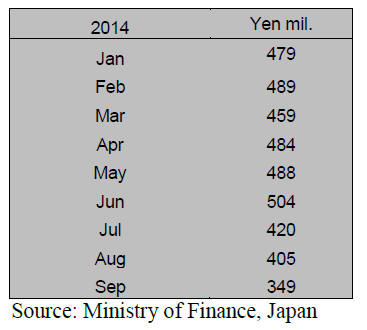
September imports of wooden window frames
China and Philippines are major suppliers of wooden
window frames to Japan and in September 2014 each
country supplied approx. 30% of all imports of wooden
window frames.
Other suppliers include the US which delivered around
20% of Japan‟s window imports for the month of
September. Of the balance the manufacturers in Europe
supplier a significant value of wooden window frames to
Japan with Sweden being the largest European supplier.
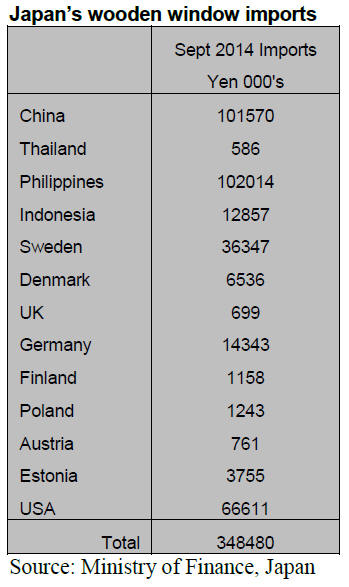
Trends in wooden window door imports
The demand for wooden doors and frames in Japan‟s
residential and commercial building sectors is substantial.
In contrast to the trend in wooden window frame imports,
imports of wooden doors between 2009 and 2012
remained fairly steady at about yen 15,000 mil. annually
but increased by 30% to yen 20,000 mil. in 2013.
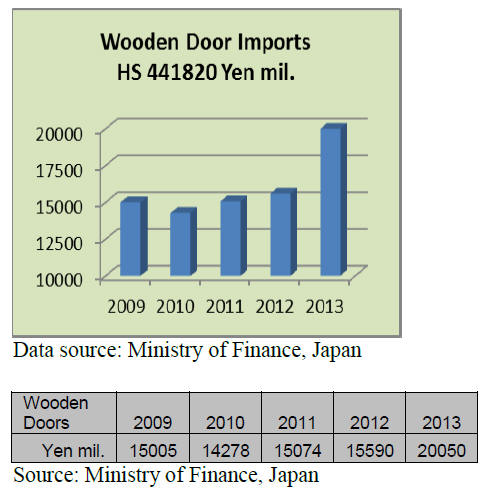
The increased level of wooden door imports continued
into the first quarter of 2014 but thereafter began a steady
decline to a point when, in the thrid quarter, imports were
back to 2012 levels. However for the year to September
2014 the value of imports of wooden doors had already
surpassed the cummulative total for 2013.
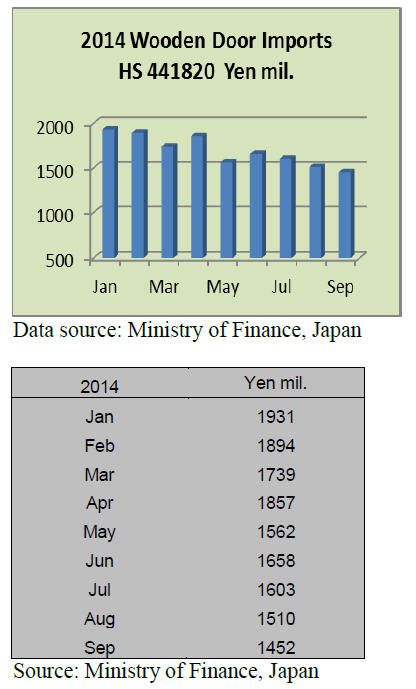
Suppliers in just five countries provided over 90% of the
value of Japan‟s imports of wooden doors. The fllowing
graphic illustrates the dominance of China as a supplier of
wooden doors to the Japanese market followed by
Philippines and Malaysia.
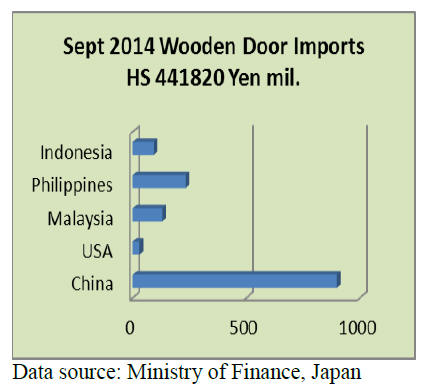
September wooden door imports
Some 62% of all Japan‟s wooden door imports in
September were supplied by manufacturers in China
follwed by Philppines (16%), Malaysia (9%) and
Indonesia another 6%. Of the remaining suppliers the US
provided 2% of Japan‟s Seotember imports of wooden
doors.
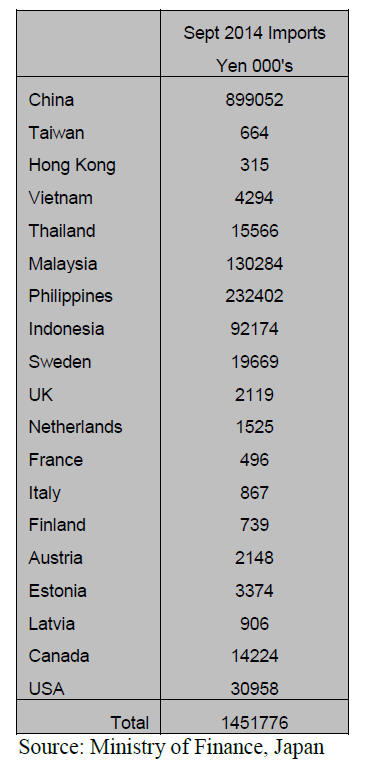
Trade news from the Japan Lumber Reports (JLR)
For the JLR report please see:
http://www.nmokuzai.
com/modules/general/index.php?id=7
Yen depreciation pushes up import costs
The recent rapid and significant depreciation of the yen
since late October pushes cost of all the imported
commodity sharply.
North American Douglas fir log prices for November
shipment are US$20 per M Scribner up FAS., making IS
sort prices of US$870. An increase in FAS dollar prices
plus weak yen will make arrived yen cost much higher,
which will impact Douglas fir lumber prices in Japan.
Export prices of South Sea hardwood plywood remain
unchanged but recent higher FOB prices with exchange
rate of about 115 yen per dollar, arrived cost of JAS 3x6
concrete forming panel would be about 1,370 yen per
sheet FOB truck port yard and coated concrete forming
panel about 1,500 yen about 150 yen per sheet higher than
current Japan market prices.
Negotiations on European lumber are in confusion as the
European suppliers intend to increase the export Euro
prices but the Japanese buyers are unable to increase the
sales prices because of market slump.
The Yen‟s depreciation comes when the demand for wood
products is sluggish with low housing starts so the yen
prices of wood products would remain weak and price
hike is impossible for a time being.
Expansion of domestic log export
The Japan Wood Products Export Promotion Council held
the first meeting for establishing of a network for cooperation
with overseas relevant organizations to promote
more wood products export from Japan.
The Ministry of Agriculture, Forestry and Fisheries sets a
target of export amount of agricultural and marine
products of one trillion yen by 2020 out of which forest
products is 25 billion yen and it is discussing to have a
measure to increase export of forest products by
constructing groups of Japanese groups and Chinese
groups.
This is a part of Forestry Agency‟s strategic project of
doubling local wood supply. Total export value through
September this year reached 12.7 billion yen, which
exceeded last year‟s total export value of 12.3 billion yen.
The total of this year would be about 15 billion yen.
The Council has been working together with Chinese
organizations to test and evaluate basic performance of
Japanese wood and to hold seminars and supply guide
book. Demand in China for Japanese wood is mainly for
concrete forming and supporting bar and structural
materials. For this purpose the main demand is for logs.
September plywood supply
Total plywood supply in September was 495,800 cbms,
2.6% less than the same month a year ago and 7.7% more
than August. Imported plywood volume has declined less
than 300,000 cbms for four consecutive months and the
monthly volume seems to stay low like 270-280,000 cbms
for coming months.
Total imported plywood volume in September was
269,800 cbms, 0.4% less than September last year and
9.1% more than August. Monthly average volume for the
first nine months was 298,600 cbms, 3.2% less than the
same period of last year.
Malaysian volume in September was 115,200 cbms, 12%
less and 16.7% more. The first increase after five months.
First nine months average is 125,300 cbms, 10.4% less
than the same period of last year.
Indonesian supply was 78,800 cbms, 20.9% more and
6.3% more but the monthly average is 87,300 cbms, only
0.4% more.
Chinese volume was 59,800 cbms, 9.1% more and 9.4%
more. Monthly average is 65,600 cbms, 0.2% less. The
supply for the first nine months from three major sources
was 5% less than the same period of last year. September
production of domestic plywood is 226,000 cbms, 5.2%
less than September last year and 6.1% more than August.
Plywood market weak
The domestic softwood plywood market is weakening.
Plywood manufacturers held strong stance since July
through September with stiff prices but as the inventories
climb and demand continues inactive, manufacturers are
not able to hold up any longer and the prices started
edging down.
September production was 210,000 cbms, 5.9% less than
September last year but 5.7% more than August. The
manufacturers announced 15% production curtailment
since July but actual reduction was only 8-9% down
except for August (vacation season).
The shipment was 219,000 cbms, 0.1% less and 13.3%
more. This is a sort of manipulated figure as September is
book closing month so that the trading firms pushed sales
regardless of the demand.
The shipment volume exceeded the production so that the
inventories were 215,400 cbms, 9,000 cbms less than
August. The market has not recovered in November and
the prices continue inching down. Current market prices of
12 mm 3x6 panel in Tokyo market are about 900 yen per
sheet delivered, 20 yen down from August.
Cost of imported plywood soared by weakening yen
despite the same export C&F dollar prices. The importers
are firmly asking higher prices since second week of
November.
The cost of future cargoes, arriving late January and early
February would be about 1,370 yen per sheet FOB truck
port yard for 3x6 JAS concrete forming panel and 1,500
yen for coated concrete forming panel while current
market prices are 1,280 yen and 1,380 yen respectively.
Looking at these high future prices, concrete forming users
immediately started buying low priced items.
|